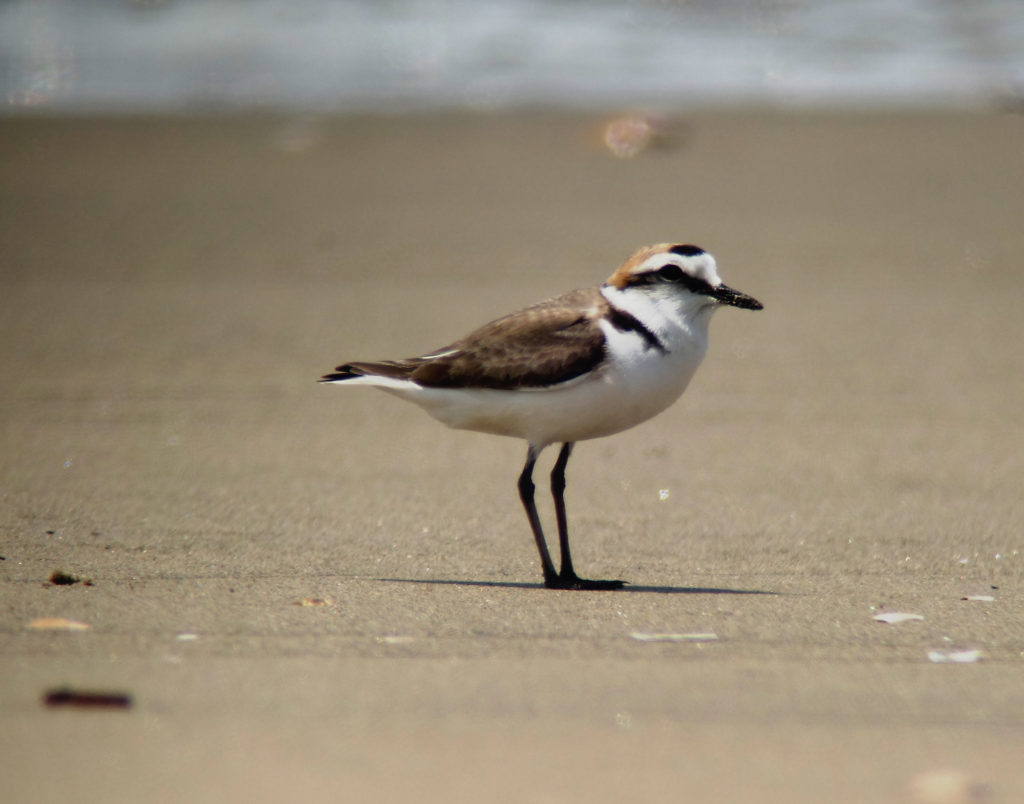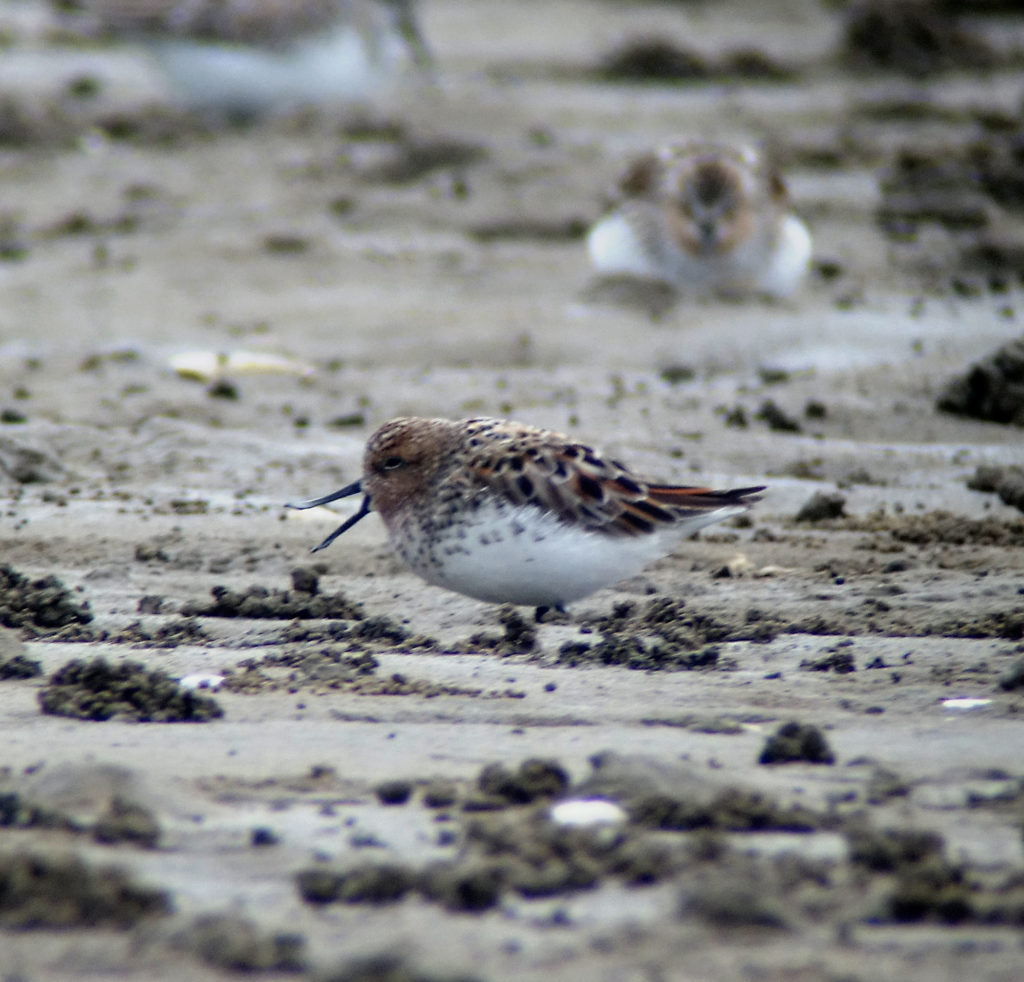Between May 23rd and 28th I conducted a third round of shorebird counts as part of a regional project on the Critically Endangered Spoon-billed Sandpiper led by the wonderful SBS in China, funded by the National Geographic Air and Water Conservation Fund (China).
On May 23rd, I counted a (miserably poor) total of only 89 shorebirds in the Nakdong Estuary, with zero Spoon-billed Sandpiper and even zero Dunlin found and with the most numerous species Sanderling (29) – showing a wonderful range of plumages – and Kentish Plover (25). The number of Little Tern was also very low, with only 62 counted in total. The only other species of note were a single Western Osprey and an overflying group of 17 Oriental Honey Buzzard heading southwest.

 Sanderling Calidris alba © Nial Moores
Sanderling Calidris alba © Nial Moores
 Kentish Plover Charadrius alexandrinus © Nial Moores
Kentish Plover Charadrius alexandrinus © Nial Moores
On May 24th, conditions were too poor to make accurate counts at the Geum barrage (although many hundreds of birds still remained) and on May 25th I spent the whole day at Yubu, crossing at 04:15 and leaving at 19:00. There were at least 5,700 shorebirds in total comprised of 23 or 24 species on Yubu, with most numerous Grey Plover (1,200), Broad-billed Sandpiper (750) and Red-necked Stint (650).


 Broad-billed Sandpiper Limicola falcinellus sibirica © Nial Moores. Three different individuals showing some of the range in plumage saturation. By late May, some can look very richly colored indeed (for more images and discussion of this subspecies, see this post on the Birding Mongolia website).
Broad-billed Sandpiper Limicola falcinellus sibirica © Nial Moores. Three different individuals showing some of the range in plumage saturation. By late May, some can look very richly colored indeed (for more images and discussion of this subspecies, see this post on the Birding Mongolia website).
 Red-necked Stint Calidris ruficollis © Nial Moores By late May, some look enormous (for a stint, that is!).
Red-necked Stint Calidris ruficollis © Nial Moores By late May, some look enormous (for a stint, that is!).
Among multiple additional shorebird highlights were a “new” presumed Second Calendar-year Spoon-billed Sandpiper (seen and digiscoped catching flies and pulling at blades of vegetation, though only before sunrise!) and two or three Nordmann’s Greenshank (perhaps also in “First Breeding Plumage”?).

 Spoon-billed Sandpiper Eurynorhynchus pygmeus (to right of Red-necked Stint) showing very retarded looking plumage even as late as May 25th © Nial Moores
Spoon-billed Sandpiper Eurynorhynchus pygmeus (to right of Red-necked Stint) showing very retarded looking plumage even as late as May 25th © Nial Moores


Nordmann’s Greenshank Tringa guttifer © Nial Moores
There was also a small-sized breeding-plumaged Greater Sand Plover, presumably both mongolus and stegmanni subspecies of Mongolian Plover and five Curlew Sandpiper, all of which looked portly (like most of the other birds) and three of which were in full breeding plumage. There was also a good number of Ruddy Turnstone (200) present, with two banded birds seen and still decent numbers of Terek Sandpiper (150+ logged) though rather few Grey-tailed Tattler (only 15, with several of these perhaps Second Calendar-years?).
 Grey-tailed Tattler Tringa brevipes © Nial Moores. The bird on the right had pale notching on the tertials and some pale speckling on the crown (perhaps indicating immaturity); the bird on the left lacked either of these features.
Grey-tailed Tattler Tringa brevipes © Nial Moores. The bird on the right had pale notching on the tertials and some pale speckling on the crown (perhaps indicating immaturity); the bird on the left lacked either of these features.
The 25th had a few ID puzzles and “what if” moments too. The first was a spoonbill with a group of 7 Black-faced Spoonbill that was obviously larger and longer-billed and –legged, that seemed to be intermediate in appearance between Eurasian and Black-faced; the second was an invisible bird heard overflying the tidal-flat giving first the “tuwit” contact call and then the display song of what I would have no hesitation in calling a Semi-palmated Plover if heard in North America.
 Black-faced Spoonbills Platalea minor and bird showing mixed characters? (on right) © Nial Moores
Black-faced Spoonbills Platalea minor and bird showing mixed characters? (on right) © Nial Moores
On 25th too, the woods on Yubu were also excellent, with a Gray’s Grasshopper Warbler, 25+ Kamchatka Leaf and two Arctic Warblers heard and seen, along with a Mugimaki and small numbers of all three of the grey-brown flycatchers.
On 26th, again conditions were too hazy with Yellow Dust and mist at the barrage to make any useful counts. On the 27th, conditions were better – but numbers had fallen to under 100 shorebirds, with Mongolian Plover (44), Terek Sandpiper (25) and Grey-tailed Tattler (10) the most numerous.
On 28th, I returned to Yubu and in four hours around the morning high tide found 2,160 shorebirds still, including another “new” Spoon-billed Sandpiper (presumably a male, as it started to sing a couple of times; and perhaps best aged as an advanced-looking Second Calendar-year, as it almost lacked red on the breast).


 Spoon-billed Sandpiper (May 28th) with Red-necked Stints © Nial Moores
Spoon-billed Sandpiper (May 28th) with Red-necked Stints © Nial Moores
There were still at least two Nordmann’s Greenshank present too and Broad-billed Sandpiper had increased slightly to at least 795, with the next most numerous species Far Eastern Oystercatcher (405), Far Eastern Curlew (305), Grey Plover (165: most of those that remained with little breeding plumage) and Great Knot (146).
 (Second Calendar-year) Far Eastern Oystercatcher Haematopus (ostralegus) osculans © Nial Moores
(Second Calendar-year) Far Eastern Oystercatcher Haematopus (ostralegus) osculans © Nial Moores
The breeding-plumaged Greater Sand Plover also remained (and was joined by a much larger and thus more typical looking individual in more or less in non-breeding plumage) and there were still 91 Mongolian Plover presumably again of both subspecies.
 Mongolian Plovers Charadrius mongolus with a single Broad-billed Sandpiper © Nial Moores. According to a paper in 2000 by Hirschfeld et al. published in British Birds, breeding plumaged male stegmanni, perhaps like the bird top right, tend to be darker above than nominate mongolus, with more extensive and deeper red on the breast and less white on the forehead.
Mongolian Plovers Charadrius mongolus with a single Broad-billed Sandpiper © Nial Moores. According to a paper in 2000 by Hirschfeld et al. published in British Birds, breeding plumaged male stegmanni, perhaps like the bird top right, tend to be darker above than nominate mongolus, with more extensive and deeper red on the breast and less white on the forehead.


 Greater Sand Plover Charadrius leschenaultii © Nial Moores. Does anyone know which subspecies this is?
Greater Sand Plover Charadrius leschenaultii © Nial Moores. Does anyone know which subspecies this is?
Although there had been 340 Sanderling on the 25th, this number had fallen to zero by the 28th – a nice capture of departure timing for this very late migrant.
Thanks again to SBS in China and Nat Geo for supporting this research; and thanks too to Swarovski Optik for providing the use of some truly superb optics.

